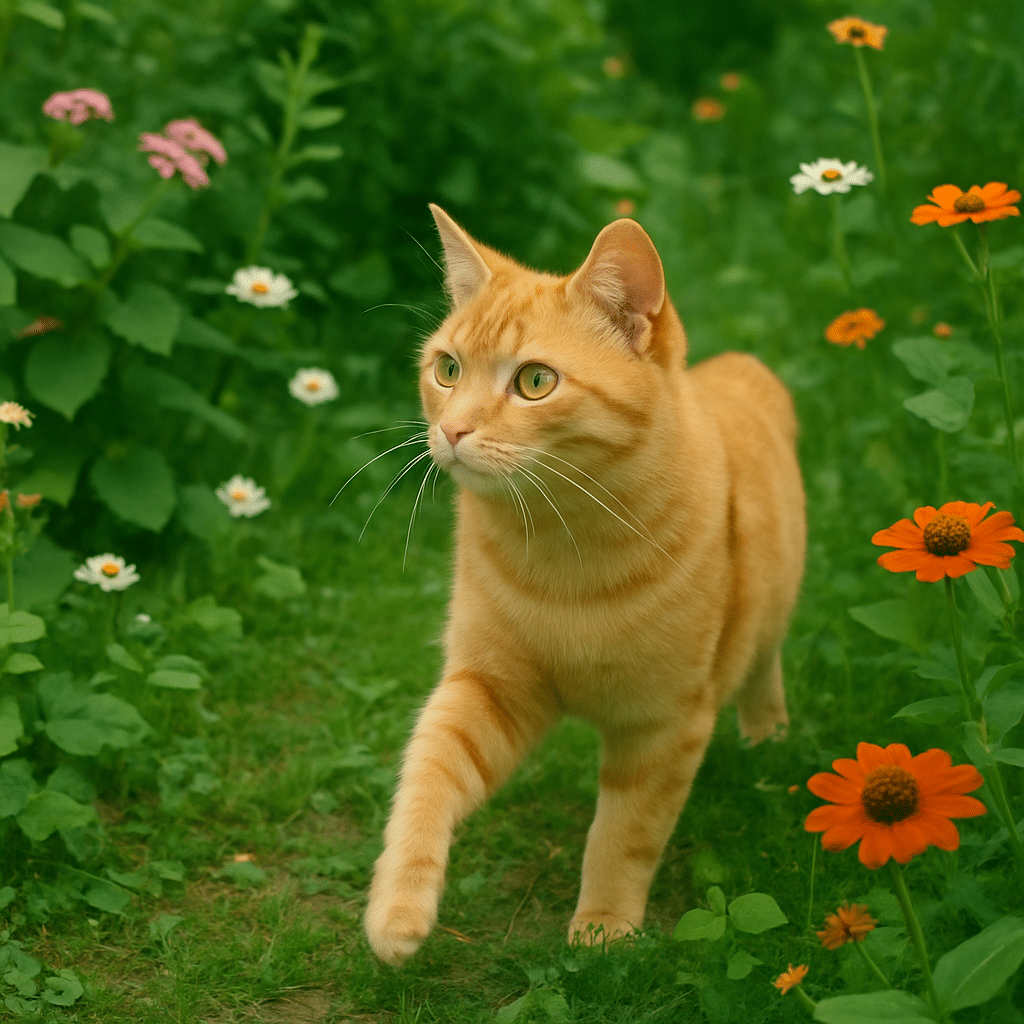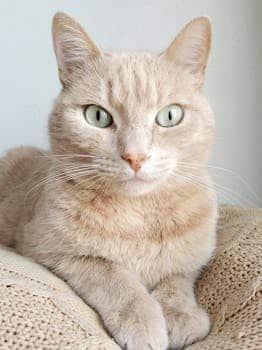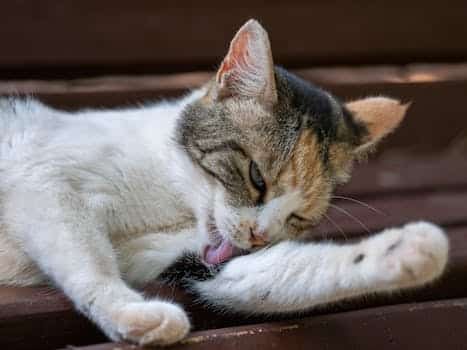Post Disclaimer
Catopedea shares information for educational and general interest purposes only. Our content is not a substitute for professional veterinary advice, diagnosis, or treatment. Always consult a licensed veterinarian for concerns about your cat’s health, diet, or behavior.
Fun Facts About Orange Cats You’ll Love
Orange cats are a delightful sight with their vibrant coats and charming personalities. These felines, often called “ginger” or “marmalade” cats, captivate cat lovers worldwideTheir striking appearance is not just about looks; it comes with fascinating genetics. Did you know that most orange tabbies are male? This is due to a unique genetic trait. Orange cats are not a specific breed but a color pattern found in many breeds. From American Shorthairs to British Shorthairs, these cats come in various shapes and sizes.
Their friendly and affectionate nature makes them popular pets. Many people find them to be more sociable and outgoing than other cats. Whether you’re a cat enthusiast or just curious, there’s much to learn about these charming creatures. Let’s dive into the world of orange cats and discover what makes them so special.

What Makes Orange Cats So Special?
Orange cats hold a special place in many hearts. This appeal lies not only in their striking color but also in their endearing qualities. These cats often exude a warmth and friendliness that make them popular pets.
Their vibrant coloring stems from the presence of pheomelanin, a pigment that gives their coat a unique hue. This distinct appearance is enough to catch anyone’s eye, but there is more to love about them.
Here are a few reasons why orange cats are extraordinary:
- They have a rich variety of coat patterns.
- Their vocal and social nature stands out.
- They are often associated with good luck.
Orange cats are renowned for their lively and adventurous spirit. Their playful energy keeps them active and engaged, often drawing comparisons to dogs for their loyal behavior.

The Genetics Behind Orange Cats: Why Are They Usually Male?
The genetics behind orange cats reveal intriguing details about their prevalence. A fascinating fact is that most orange cats are male, a result of their unique genetics. This phenomenon is due to the sex-linked nature of the orange gene.
The gene responsible for the orange color is carried on the X chromosome. Females, having two X chromosomes, require the gene on both to become orange. This rarity makes female orange cats less common.
Here’s why male dominance occurs:
- Males have one X and one Y chromosome.
- An orange gene on the X chromosome leads to an orange male.
- Only one copy is needed for a male cat to be orange.
This genetic makeup leads to about 80% of orange tabby cats being male. While it sounds complex, the outcome is a higher occurrence of male orange felines compared to females. This sex-linked genetic connection adds to the charm and intrigue of these colorful cats.
Orange Cat Patterns: More Than Just Tabby Stripes
Orange cats exhibit a variety of stunning patterns that captivate cat lovers everywhere. While tabby stripes are the most common, these cats have more design diversity than one might expect. Each pattern brings out a different facet of their charming personality.
The classic tabby pattern is characterized by bold, swirling stripes that loop across their back. Some orange cats have a mackerel pattern, showcasing narrow, parallel stripes similar to a fish skeleton. These stripes create a sleek, dynamic look.
Additionally, the spotted tabby pattern decorates some orange cats with small, distinct spots that resemble leopard prints. This unique pattern adds an exotic flair to their appearance. The ticked pattern is subtler, featuring small, speckled markings rather than stripes or spots.
Here’s a list of common orange cat patterns:
- Classic Tabby: swirling bold stripes
- Mackerel Tabby: narrow, parallel stripes
- Spotted Tabby: distinct leopard-like spots
- Ticked Tabby: subtle, speckled markings
Not confined to pattern, orange cats also vary in coat length. These feline fashionistas can have either long or short hair, further diversifying their looks.
Orange and White Cats: Names, Breeds, and Unique Looks
Orange and white cats boast a striking and distinctive appearance that cat enthusiasts adore. These cats often go by enchanting names like “bicolor” or “piebald.” Their charming color combination creates a pattern that stands out uniquely among feline companions.
These orange and white beauties can be found in several popular cat breeds. Breeds such as the Maine Coon, Persian, and American Shorthair frequently feature this eye-catching color combination. Each breed brings its own flair to the orange and white palette, adding diversity to this striking pattern.
Here is a snapshot of common orange and white cat breeds:
- Maine Coon
- Persian
- American Shorthair
Beyond breeds, their unique color mix gives these cats a playful and cheerful look that is irresistible. The way their orange patches contrast with snowy white creates a vibrant visual spectacle. The result is always stunning and unique, with no two orange and white cats looking exactly alike.
Popular Breeds That Feature Orange Cats
Orange cats aren’t limited to just one breed. Their delightful hue can be spotted across many beloved feline breeds. These cats can charm any cat lover with their vibrant coats and loving nature.
Several breeds are known for featuring orange tabbies. Among these, the American Shorthair, British Shorthair, and Maine Coon are popular choices. Each breed boasts distinct traits while sharing the classic orange color that captures our hearts.
Here’s a glimpse at some common orange cat breeds:
- American Shorthair
- British Shorthair
- Maine Coon
The American Shorthair is particularly known for its robust physique and playful demeanor. British Shorthairs bring a calm, composed nature complemented by their dense fur. Meanwhile, the Maine Coon, one of the largest domestic cat breeds, is famed for its amiable and gentle temperament alongside its magnificent orange coat.
These diverse breeds prove that orange isn’t just a color—it’s a statement of warmth and companionship.
Personality Traits: Are Orange Cats Really Friendlier?
Orange cats are often noted for their delightful and engaging personalities. Many cat enthusiasts claim these cats are particularly friendly and affectionate. Their warm hue seems to mirror their inviting nature.
While personality can vary by individual, orange cats often exhibit several charming traits. They are known to be playful, social, and curious, creating a joyful environment for their owners. Their love for interaction makes them a favorite among families and cat lovers alike.
Here are some notable personality traits of orange cats:
- Playful and energetic
- Sociable and engaging
- Curious and adventurous
Their lively demeanor makes them great companions. Orange cats have a knack for making their presence felt, ensuring they are never far from the action. Though there’s no scientific proof that color affects personality, many orange tabby owners wouldn’t have it any other way.
How Big Do Orange Cats Get? Size and Lifespan Facts
Orange cats come in various sizes, largely depending on their breed. Most orange cats are medium to large in size, showcasing an impressive and sturdy build. Their weight and size can also reflect their healthy appetite and active lifestyle.
In general, male orange cats tend to be larger than females. This is especially true for the orange tabby, which is more likely to be male due to genetic factors. On average, a big orange cat can weigh between 10 to 18 pounds.
Key size and lifespan facts include:
- Typical lifespan: 12 to 15 years
- Average weight: 10-18 pounds
- Larger size usually seen in males
Understanding the size and lifespan of orange cats helps owners provide appropriate care and nutrition. A healthy size supports their lively demeanor, ensuring they remain happy and energetic throughout their lives.
Famous Orange Cats in Pop Culture and History
Orange cats have left a paw print on pop culture, captivating audiences worldwide. Their vibrant color and charming personalities have made them stars in various media. From cartoons to movies, they continue to enchant and entertain.
Some iconic orange cats have become household names. Garfield, the lasagna-loving comic strip cat, is arguably one of the most famous. Morris the Cat, known from the 9Lives commercials, also cemented an iconic status with his witty charm.
Here’s a quick list of some beloved orange cats:
- Garfield from “Garfield”
- Morris the Cat from 9Lives commercials
- Orangey, who starred in “Breakfast at Tiffany’s”
These orange cat icons not only represent feline charm but also highlight the playful and lovable nature orange cats are famous for.
Fun and Surprising Facts About Orange Kittens
Orange kittens are bundles of joy wrapped in a coat of vivid color. These tiny furballs often captivate cat lovers with their playful antics and curious nature. Watching them play is like watching a miniature circus unfold in your living room.
One intriguing aspect of orange kittens is that they are usually more vocal than their less colorful peers. This vocal nature often makes them seem more sociable and interactive. Their unique personalities shine through as they explore their surroundings with boundless energy and curiosity.
Here’s a list of fun facts about orange kittens:
- Orange kittens are born with their markings.
- They often have green or amber eyes.
- Most orange kittens grow up to be social cats.
Orange kittens may be small, but they have plenty of personality packed into their tiny bodies. Their playful nature and vibrant appearance make them a favorite among cat enthusiasts.
Myths, Legends, and Folklore About Orange Cats
Orange cats have been part of human lore for centuries, often seen as symbols of luck and adventure. Many cultures feature tales of orange cats bringing warmth and energy to those they encounter. These stories often highlight their unique color and friendly demeanor.
Here are a few myths and legends about orange cats:
- Associated with prosperity in some cultures.
- Believed to ward off bad spirits.
- Considered symbols of autumn.
These fascinating tales add an air of mystery to these colorful cats, enhancing their appeal as both pets and companions.
Should You Adopt an Orange Cat? What to Know
Orange cats are charming and add warmth to any home. Known for their playful and friendly nature, they often bond well with families and other pets. Their vibrant coat and lively personality make them an appealing choice for many pet lovers.
Before adopting, consider these key points:
- They require regular grooming.
- They are often vocal and social.
- They may need more playtime.
Adopting an orange cat can bring joy and companionship. Their sunny disposition and spirited antics are sure to brighten your days.
Why are most orange cats male?
About 80% of orange cats are male due to genetics. The orange color gene is on the X chromosome males (XY) only need one copy, while females (XX) need two. This makes female orange cats rarer (only 20% of orange tabbies).
Are orange cats friendlier than other cats?
While personality varies, many owners report orange cats as more sociable and affectionate. A 2022 survey by Cat Behavior Alliance found 68% of orange tabby owners described them as “exceptionally outgoing” possibly linked to their bold, adventurous nature.
What famous cartoon cats are orange?
The most iconic orange cats include:
Garfield (lasagna-loving comic star)
Morris (9Lives mascot)
Orangey (Hollywood cat from Breakfast at Tiffany’s)
Crookshanks (Hermione’s cat in Harry Potter)
Do orange cats have more health problems?
No—coat color doesn’t affect health. However, male orange cats (like all males) are slightly more prone to urinary blockages. Regular vet checkups and hydration prevent issues. Source: Cornell Feline Health Center
Should I adopt an orange cat if I have kids?
Yes! Orange cats are often great with kids due to their playful, tolerant nature. Supervise early interactions and teach children gentle handling. Breeds like Maine Coons (common in orange) are especially patient.
Conclusion: Why We Love Orange Cats
Orange cats hold a special charm and warmth that captivates cat lovers. Their lively personalities and unique coloring make them stand out among feline companions. Known for their sociable and friendly nature, they effortlessly win the hearts of their human families.
Beyond their good looks and friendly demeanor, orange cats bring joy and laughter into any home. Their playful antics, combined with their affectionate behavior, create an unforgettable feline companionship experience. Loving an orange cat truly means having a delightful, furry friend by your side.


